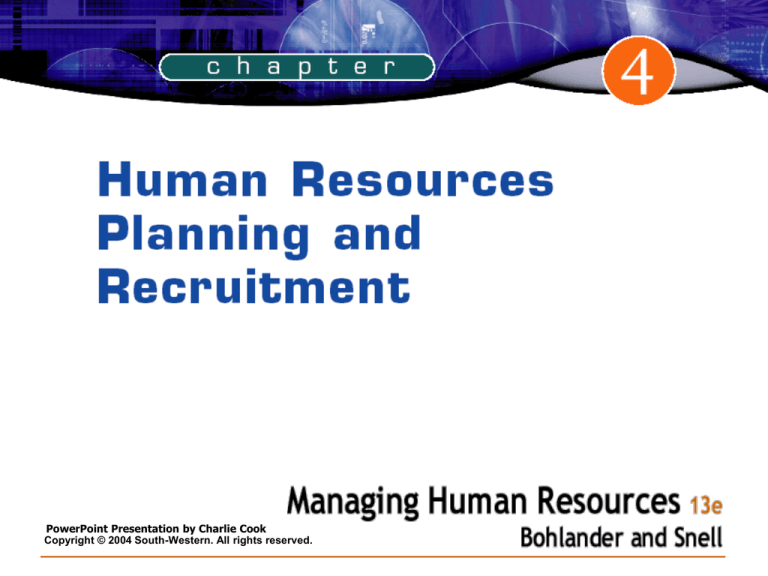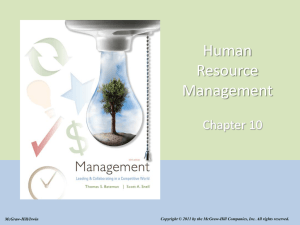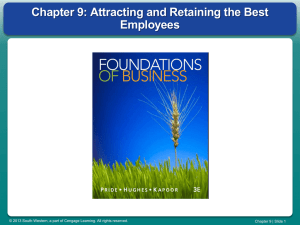
PowerPoint Presentation by Charlie Cook
Copyright © 2004 South-Western. All rights reserved.
Objectives
After studying this chapter, you should be able to:
1. Identify the advantages of integrating human
resources planning and strategic planning.
2. Describe the basic approaches to human resources
planning.
3. Explain the advantages and disadvantages of
recruiting from within the organization.
4. Explain the advantages and disadvantages of
external recruitment.
5. Describe how recruitment activities are integrated
with diversity and equal employment opportunity
initiatives.
Copyright © 2004 South-Western. All rights reserved.
4–2
Human Resources Planning
• Human Resources Planning (HRP)
Process of anticipating and making provision for the
movement (flow) of people into, within, and out of an
organization.
HRP’s purpose is the the effective deployment of
human resources through:
Anticipating organizational labor supply and demand.
Providing expanded employment opportunities for
women, minorities, and the disabled.
Guiding the development and training the workforce.
Copyright © 2004 South-Western. All rights reserved.
4–3
HRP and Strategic Planning
• Strategic Analysis
What human resources are needed and what are
available?
• Strategic Formulation
What is required and necessary in support of human
resources?
• Strategic Implementation
How will the human resources be allocated?
Human Resources
Planning
Copyright © 2004 South-Western. All rights reserved.
Strategic
Planning
4–4
Linking the Processes of HRP and Strategic
Planning
Strategic
Analysis
Establish the context:
• Business goals
• Company
strengths/weaknesses
• External
opportunities/threats
• Source of competitive
advantage
Identify people-related
business issues
Strategy
Formulation
Clarify performance
expectations and future
management method:
• Values, guiding
principles
• Business mission
• Objectives and priorities
• Resource allocations
Define HR strategies,
objectives, and action plans
Source: Adapted from James W. Walker, “Integrating the Human Resource Function with the
Business,” Human Resource Planning 14, no. 2 (1996): 59–77. Reprinted with permission.
Copyright © 2004 South-Western. All rights reserved.
Strategy
Implementation
Implement processes to
achieve desired results:
• Business goals
• Company
strengths/weaknesses
• External
opportunities/threats
• Source of competitive
advantage
Implement HR processes,
policies, and practices
Presentation Slide 4–1
Figure 4.1
4–5
Mapping an Organization’s Human Capital
Architecture
• Core knowledge workers
Employees who have firm-specific skills that are
directly linked to the company’s strategy.
Example: Senior software programmer
• Traditional job-based employees
Employees with skills to perform a predefined job
that are quite valuable to a company, but not unique.
Example: Security guard
Copyright © 2004 South-Western. All rights reserved.
4–6
Mapping an Organization’s Human Capital
Architecture (cont’d)
• Contract labor
Employees whose skills are of less strategic value
and generally available to all firms.
Example: General electrician
• Alliance/partners
Individuals and groups with unique skills, but those
skills are not directly related to a company’s core
strategy.
Example: Independent product label designer
Copyright © 2004 South-Western. All rights reserved.
4–7
Mapping Human Capital
Presentation Slide 4–2
Source: Scott A. Snell, Cornell University.
Copyright © 2004 South-Western. All rights reserved.
Figure 4.2
4–8
Ensuring the Fit between HR and Strategy
• External Fit (or External Alignment)
Focuses on the connection between the business
objectives and the major initiatives in HR.
• Internal Fit (or Internal Alignment)
Aligning HR practices with one another to establish a
configuration that is mutually reinforcing.
Copyright © 2004 South-Western. All rights reserved.
4–9
Achieving
Strategic Fit
At
Continental
Airlines
HRM 1
Source: Company document.
Copyright © 2004 South-Western. All rights reserved.
4–10
Strategic Flexibility
• Organizational Capability
Capacity of the organization to act and change in
pursuit of sustainable competitive advantage.
Coordination flexibility
The ability to rapidly reallocate resources to new or
changing needs.
Resource flexibility
Having human resources who can do many different
things in different ways.
Copyright © 2004 South-Western. All rights reserved.
4–11
HRP and Environmental Scanning
• Environmental Scanning
The systematic monitoring of the major external
forces influencing the organization.
Economic factors: general and regional conditions
Competitive trends: new processes, services, and
innovations
Technological changes: robotics and office automation
Political and legislative issues: laws and administrative
rulings
Social concerns: child care and educational priorities
Demographic trends: age, composition,and literacy
Copyright © 2004 South-Western. All rights reserved.
4–12
Scanning the Internal Environment
• Cultural Audits
Audits of the culture and quality of work life in an
organization.
How do employees spend their time?
How do they interact with each other?
Are employees empowered?
What is the predominant leadership style of managers?
How do employees advance within the organization?
• Benchmarking
The process of comparing the organization’s
processes and practices with those of other
companies.
Copyright © 2004 South-Western. All rights reserved.
4–13
The Top Ten Measures Of Human Capital
• Your most important issues
• Human capital value added
• Human capital ROI
• Separation cost
• Voluntary separation rate
• Total labor-cost/revenue percentage
• Total compensation/revenue percentage
• Training investment factor
• Time to start
• Revenue factor
HRM 2
Copyright © 2004 South-Western. All rights reserved.
4–14
Human Resource Planning Model
FORECASTING DEMAND
Considerations
• Product/service demand
• Technology
• Financial resources
• Absenteeism/turnover
• Organizational growth
• Management philosophy
Techniques
• Staffing tables
• Markov analysis
• Skills inventories
• Management inventories
• Replacement charts
• Succession Planning
Techniques
• Trend analysis
• Managerial estimates
• Delphi technique
BALANCING
SUPPLY AND
DEMAND
(Shortage)
Recruitment
• Full-time
• Part-time
• Recalls
External Considerations
• Demographic changes
• Education of the workforce
• Labor Mobility
• Government policies
• Unemployment rate
FORECASTING SUPPLY
Copyright © 2004 South-Western. All rights reserved.
(Surplus)
Reductions
• Layoffs
• Terminations
• Demotions
• Retirements
Presentation Slide 4–3
Figure 4.3
4–15
Forecasting Demand for Employees
Quantitative Methods
Forecasting Demand
Qualitative Methods
Copyright © 2004 South-Western. All rights reserved.
4–16
Quantitative Approach: Trend Analysis
• Forecasting labor demand based on an
organizational index such as sales:
Select a business factor that best predicts human
resources needs.
Plot the business factor in relation to the number of
employees to determine the labor productivity ratio.
Compute the productivity ratio for the past five years.
Calculate human resources demand by multiplying
the business factor by the productivity ratio.
Project human resources demand out to the target
year(s).
Copyright © 2004 South-Western. All rights reserved.
4–17
Example of Trend Analysis of HR Demand
BUSINESS
FACTOR
YEAR
(SALES IN THOUSANDS)
LABOR
PRODUCTIVITY
(SALES/EMPLOYEE)
=
HUMAN RESOURCES
DEMAND
(NUMBER OF EMPLOYEES)
1997
$2,351
14.33
164
1998
$2,613
11.12
235
1999
$2,935
8.34
352
2000
$3,306
10.02
330
2001
$3,613
11.12
325
2002
$3,748
11.12
337
2003
$3,880
12.52
310
2004*
$4,095
12.52
327
2005*
$4,283
12.52
342
2006*
$4,446
12.52
355
*Projected figures
Copyright © 2004 South-Western. All rights reserved.
Figure 4.4
4–18
Qualitative Approaches to Demand
Forecasting
• Management Forecasts
The opinions (judgments) of supervisors, department
managers, experts, or others knowledgeable about
the organization’s future employment needs.
• Delphi Technique
An attempt to decrease the subjectivity of forecasts
by soliciting and summarizing the judgments of a
preselected group of individuals.
The final forecast represents a composite group
judgment.
Copyright © 2004 South-Western. All rights reserved.
4–19
Forecasting Supply of Employees: Internal
Labor Supply
• Staffing Tables
• Markov Analysis
• Skill Inventories
• Replacement Charts
• Succession Planning
Copyright © 2004 South-Western. All rights reserved.
4–20
Forecasting Internal Labor Supply
• Staffing Tables
Graphic representations of all organizational jobs,
along with the numbers of employees currently
occupying those jobs and future (monthly or yearly)
employment requirements.
• Markov Analysis
A method for tracking the pattern of employee
movements through various jobs.
Copyright © 2004 South-Western. All rights reserved.
4–21
Hypothetical Markov Analysis for a Retail Company
Copyright © 2004 South-Western. All rights reserved.
Figure 4.5
4–22
Internal Demand Forecasting Tools
• Skill Inventories
Files of personnel education, experience, interests,
skills, etc., that allow managers to quickly match job
openings with employee backgrounds.
• Replacement Charts
Listings of current jobholders and persons who are
potential replacements if an opening occurs.
• Succession Planning
The process of identifying, developing, and tracking
key individuals for executive positions.
Copyright © 2004 South-Western. All rights reserved.
4–23
An Executive
Replacement
Chart
Figure 4.6
Copyright © 2004 South-Western. All rights reserved.
4–24
Forecasting Supply of Employees: External
Labor Supply
• Factors Influencing the External Labor Supply:
Demographic changes in the population
National and regional economics
Education level of the workforce
Demand for specific employee skills
Population mobility
Governmental policies
Copyright © 2004 South-Western. All rights reserved.
4–25
Sources of Information About External
Labor Markets
• U.S. Department of Labor publications
Bureau of Labor Statistics (BLS)
Monthly Labor Review
Occupational Outlook Handbook
• State and local planning and development
agencies
• Chambers of Commerce
• Industry and trade group publications
• State and local employment agencies
Copyright © 2004 South-Western. All rights reserved.
4–26
College Graduates in
the Labor Force, 2000
(Thousands)
Copyright © 2004 South-Western. All rights reserved.
Figure 4.7
4–27
Labor Supply and Demand Issues
• Balancing supply and demand considerations
• Organizational downsizing
• Making layoff decisions
Copyright © 2004 South-Western. All rights reserved.
4–28
Growth Rate of Prime-Age College
Educated Employees
Copyright © 2004 South-Western. All rights reserved.
Figure 4.8
4–29
Recruiting within the Organization
• Benefits of a promotion-from-within policy:
Capitalizes on past investments (recruiting, selecting,
training, and developing) in current employees.
Rewards past performance and encourages
continued commitment to the organization.
Signals to employees that similar efforts by them will
lead to promotion.
Fosters advancement of members of protected
classes within an organization.
Copyright © 2004 South-Western. All rights reserved.
4–30
Recruiting within the Organization
• Limitations of a promotion-from-within policy:
Current employees may lack the knowledge,
experience or skills needed for placement in the
vacant/new position.
The hazards of inbreeding of ideas and attitudes
(“employee cloning”) increase when no outsiders are
considered for hiring.
The organization has exhausted its supply of viable
internal candidates and must seek additional
employees in the external job market.
Copyright © 2004 South-Western. All rights reserved.
4–31
Internal Methods of Locating Qualified Job
Candidates
• Human Resources Information Systems (HRIS)
Database systems containing the records and
qualifications of each employee that can be accessed
to identify and screen candidates for an internal job
opening.
• Job Posting and Bidding
Posting vacancy notices and maintaining lists of
employees looking for upgraded positions.
Copyright © 2004 South-Western. All rights reserved.
4–32
Recruiting Outside the Organization
• Labor Market
Area from which applicants are to be recruited.
Tight market: high employment, few available workers
Loose market: low employment, many available workers
• Factors determining the relevant labor market:
Skills and knowledge required for a job
Level of compensation offered for a job
Reluctance of job seekers to relocate
Ease of commuting to workplace
Location of job (urban or nonurban)
Copyright © 2004 South-Western. All rights reserved.
4–33
Outside Sources of Recruitment
• Advertisements
• Unsolicited applications
and resumes
• Internet recruiting
• Employee referrals
• Executive search firms
• Educational institutions
• Professional
organizations
Copyright © 2004 South-Western. All rights reserved.
• Labor unions
• Public employment
agencies
• Private employment
agencies
• Temporary help
agencies
• Employee leasing
4–34
Effectiveness of Recruitment Sources
Source: David E. Terpstra, “The Search for Effective Methods.” Reprinted from HRFocus, May 1996.
© 1996 American Management Association International. Reprinted by permission of American
Management Association International, New York, NY. All rights reserved. http://www.amanet.org/.
Copyright © 2004 South-Western. All rights reserved.
Figure 4.9
4–35
Increasing the Effectiveness of Employee
Referrals
• Up the ante.
• Pay for performance.
• Tailor the program.
• Increase visibility.
• Keep the data.
• Rethink your taboos.
• Widen the program.
• Measure the results.
Copyright © 2004 South-Western. All rights reserved.
4–36
Hot Recruiting Sites
• Career Builder: http://www.careerbuilder.com
Carries its own listings and offers links to sixteen specialized
career sites.
• Employment Guide: http://www.employmentguide.com
Another leading career resource site, has thousands of job
listings from hundreds of major companies.
• FlipDog: http://www.flipdog.com
Features more than 400,000 jobs and 57,000 employers in
3,700 locations.
• HotJobs: http://www.hotjobs.com
Owned by Yahoo, offers advanced management features and
smart agents to streamline the recruiting process.
HRM 6
Copyright © 2004 South-Western. All rights reserved.
4–37
Hot Recruiting Sites
• JOBTRAK: http://www.jobtrak.com
A leading college recruiting site, has more than 40,000 listings
and links to 750 campuses in the United States.
• JobWeb: http://www.jobweb.com
A college recruiting site run by the National Association of
Colleges and Employers.
• Monster.com: http://www.monster.com
One of the oldest and largest general recruiting sites on the
Internet, with more than 50,000 listings.
• Net-Temps: http://www.nettemps.com
The web’s leading site for recruiting temps
• Spherion (formerly E. Span): http://www.spherion.com
One of the largest and best-known web recruiting sites.
HRM 6
Copyright © 2004 South-Western. All rights reserved.
4–38
Factors That Motivate Top Talent
Source: E. G. Chambers, H. Hanafield-Jones, S. M. Hankin, and E. G. Michaels, III, “Win the War for Top
Talent,” Workforce 77, no. 12 (December 1998): 50–56. Used with permission of McKinsey & Co.
Copyright © 2004 South-Western. All rights reserved.
Figure 4.10
4–39
Best and Worst Majors for Job-Hunting Graduates
Source: Patrick Scheetz, Employment Research Institute, Michigan State University.
Copyright © 2004 South-Western. All rights reserved.
Figure 4.11
4–40
Occupational Breakdown of
Temporary Help Agency
Placements
Source: Steve Jones, “You’ve Come a Long Way, Baby: What the Staffing Industry
Offers Today,” Canadian HR Reporter 14, no. 19 (November 5, 2001): 15.
Copyright © 2004 South-Western. All rights reserved.
Figure 4.12
4–41
Improving the Effectiveness
of External Recruitment
Calculate Yield Ratios
Training Recruiters
External
Recruitment
Realistic Job Previews
Copyright © 2004 South-Western. All rights reserved.
4–42
External Recruitment Considerations
• Yield Ratio
Percentage of applicants from a recruitment source
that make it to the next stage of the selection process.
100 resumes received, 50 found acceptable = 50% yield.
• Cost of Recruitment (per employee hired)
SC AC AF RB NC
H
H
SC
AC
AF
RB
NC
H
= source cost
= advertising costs, total monthly expenditure (example: $28,000)
= agency fees, total for the month (example: $19,000)
= referral bonuses, total paid (example: $2,300)
= no-cost hires, walk-ins, nonprofit agencies, etc. (example: $0)
= total hires (example: 119)
Cost to hire one employee = $414
Copyright © 2004 South-Western. All rights reserved.
4–43
External Recruitment Considerations
• Sources of Organizational Recruiters
Professional HR recruiters
HR generalists
Work team members
• Requirements for Effective Recruiters
Knowledge of the recruited job’s requirements and of
the organization
Training as an interviewer
Personable and competent to represent the
organization
Copyright © 2004 South-Western. All rights reserved.
4–44
External Recruitment Considerations
• Realistic Job Previews (RJP)
Informing applicants about all aspects of the job,
including both its desirable and undesirable facets.
Positive benefits of RJP
Improved employee job satisfaction
Reduced voluntary turnover
Enhanced communication through honesty and
openness
Realistic job expectations
Copyright © 2004 South-Western. All rights reserved.
4–45
Issues in Recruiting Protected Classes
• Recruitment of Women
Growth of women in the workplace
Increase in females in management roles
Stereotyping and gender conflicts
• Recruitment of Minorities
Educational and societal disadvantages
Retention in organizations
Affirmative action
Copyright © 2004 South-Western. All rights reserved.
4–46
Top Female Executives
RANK NAME
COMPANY
POSITION
1
Carly Fiorina
Hewlett-Packard
Chairman and CEO
2
Meg Whitman
eBay
President and CEO
3
Oprah Winfrey
Harpo Ent. Group
Chairman
4
Andrea Jung
Avon
Chairman and CEO
5
Marce Fuller
Mirant
President and CEO
6
Anne Mulcahy
Xerox
President and CEO
7
Karen Katen
Pharma Group, Pfizer
EVP and President
8
Pat Woertz
Chevron (Products)
President
9
Betsy Holden
Kraft Foods
Co-CEO
10
Indra Nooyi
PepsiCo
President and CFO
Source: Adapted from Ann Harrington, “The Power 50,” Fortune 144, no. 7 (October 15, 2001): 195–98.
Copyright © 2004 South-Western. All rights reserved.
Figure 4.13
4–47
Issues in Recruiting Protected Classes
• Recruitment of the Disabled
Increasing numbers of disabled in the workforce
Stereotyping of the disabled versus their superior
records for dependability, attendance, motivation and
performance
Accommodations for physical and mental disabilities
• Recruitment of Older People
Increasingly returning to the workplace
Have valued knowledge, experience, flexibility and
reliability as employees
Copyright © 2004 South-Western. All rights reserved.
4–48
Copyright © 2004 South-Western. All rights reserved.
4–49
Employee Turnover Rates
• Computing Turnover Rates:
Copyright © 2004 South-Western. All rights reserved.
4–50
Employee Turnover Rates (cont’d)
• Computing Turnover Rates (cont’d):
Copyright © 2004 South-Western. All rights reserved.
4–51
Employee Absenteeism Rates
• Computing Absenteeism Rates
Copyright © 2004 South-Western. All rights reserved.
4–52
Costs Associated With The Turnover Of One Computer Programmer
(Turnover costs = Separation costs + Replacement costs + Training costs)
Separation costs
1. Exit interview cost for salary and benefits of both interviewer and departing employee
during the exit interview = $30+$30 = $60
2. Administrative and record-keeping action = $30
Total separation costs = $60 + $30 = $90
Replacement costs
1.
2.
3.
4.
5.
Advertising for job opening = $2,500
Preemployment administrative functions and record-keeping action = $100
Selection interview = $250
Employment tests = $40
Meetings to discuss candidates (salary and benefits of managers while participating in
meetings )= $250
Total replacement costs = $2,500 + $100 + $250 + $40 + $250 = $3,140
Training costs
1. Booklets, manuals, and reports = $50
2. Education = $240/day for new employee’s salary and benefits x 10 days of workshops,
seminars, or courses = $2,400
3. One-to-one coaching = ($240/day/new employee + $240/day/staff coach or job expert) x 20
days of one-to-one coaching = $9,600
4. Salary and benefits of new employee until he or she gets “up to par” = $240/day for salary
and benefits x 20 days = $4,800
Training costs = $50 + $2,400 + $9,600 + $4,800 = $16,850
Total turnover costs= $90 + $3,140 + $16,850 = $20,080
Source: Adapted from Michael W. Mercer, Turning Your Human Resources Department into a Profit Center (New York: AMACOM, 1993). Copyright
1993 Michael W. Mercer. Reproduced with permission from Michael W. Mercer, Ph.D., Industrial Psychologist, The Mercer Group, Inc., Chicago, Ill.
Copyright © 2004 South-Western. All rights reserved.
HRM 5
4–53





